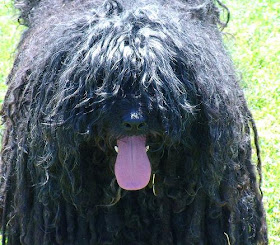The puli is a herding dog that comes from Hungary. It has what is called a corded coat, and that makes it look like a mop, but really it is a dog. At least that's what Wikipedia and some other sources say. I have never met a puli in person, and neither has Mom, so we cannot be totally sure that there is a dog in there under that funny-looking hair, but we think there probably is.
In Hungarian, the plural of puli is pulik, but those of us who speak English usually just say "pulis." These dogs are most often black in color, but they can also be white, gray, or cream. There is one variety of the cream-colored pulis that have black masks. Many white pulis have blue eyes, and they are called Roxies. I don't know why they are called that. I am just telling you what I learned from my in-depth research.
The puli is a medium-sized dog, with males being about 17 inches tall and females 16.5 inches. The females weigh between 23 and 25 pounds, and the males weigh a little more than that. When a puli is about 6 months old, it starts to get a corded coat, and this happens because the woolly undercoat gets matted with the tougher hairs of the outer coat. Puli owners separate the mats by hand so that each cord is about the width of a pencil.
Besides the coat separation, the only other grooming that a puli needs is bathing. It's easy to bathe a puli, but drying it takes a long time. If you use a dryer, it will take several hours to dry your puli, and if you just let it dry naturally, it will take about two days to be completely dry. So in this way, pulis really are kind of like mops, because mops also take a long time to dry. Some puli owners trim their dogs' hair so that they can be cooler in hot weather. Of course, if you are showing a puli you cannot cut its coat off because you would be laughed out of the show ring.
Pulis are very smart and easy to train. They can run fast and make sharp turns, and these are very useful skills for herding sheep. People who don't have sheep for their pulis to herd can teach the dogs to do agility, flyball, tracking, rally obedience, or obedience. The main thing is that pulis need plenty of exercise, and they like having a job to do. When it comes to being a family dog, a puli is loyal and playful and makes a good guard dog. Pulis usually live to be 12 years old or even older.
In Asia, there were pulis 2,000 years ago, and there might have even been some puli-like dogs as early as 6,000 years ago. It's possible that the puli was the ancestor of the modern poodle, but this is not proven for sure. The way that pulis got to Hungary is that they came with the Magyars, who are the ethnic people who settled in the area we now call Hungary. The Magyars used pulis to herd their sheep, and they used the bigger komondor breed to guard the flocks. The komondor also has a corded coat, but it is usually white.
The puli breed was recognized by the AKC in 1936, but during World War II, the breed almost died out completely. Now there are breeders who are trying to increase the numbers of these dogs, but they are still not as popular as they were at one time. Which is kind of sad because it seems like more people should want to live with these cute moplike dogs.






No comments:
Post a Comment